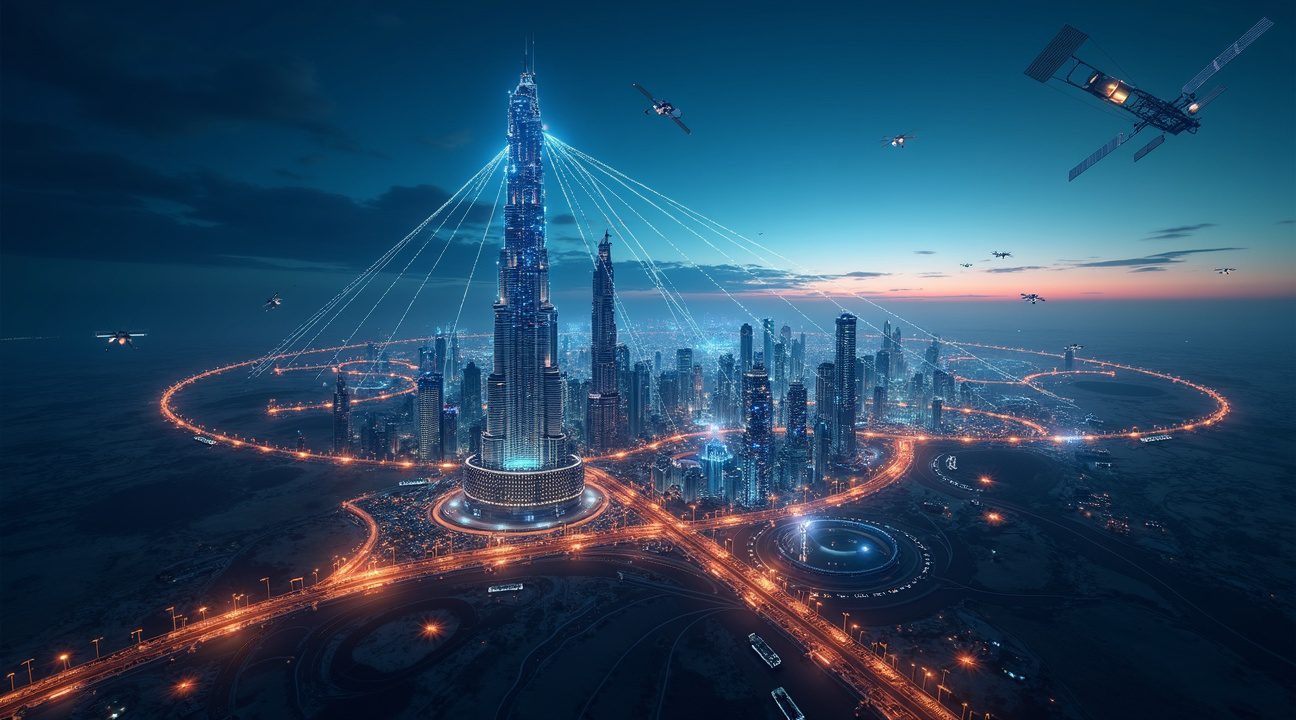UAE Achieves Groundbreaking 6G Wireless Milestone
The UAE has achieved a revolutionary breakthrough in wireless technology by successfully testing 6G networks at an unprecedented 145 gigabits per second, enabling users to download nine high-definition movies in just one second.
This milestone marks a 15-fold increase over current 5G maximum speeds and establishes new global standards for internet connectivity through advanced Terahertz frequency technology. The implications for consumer usage, industrial functionality, and international collaboration are far-reaching.
Key Takeaways
- The UAE’s 6G test reached 145 Gbps, which is 15 times faster than 5G’s theoretical maximum of 10 Gbps, allowing nine movies to be downloaded simultaneously in one second
- Utilizing Terahertz (THz) frequency technology that enables dual-purpose functionality as both data transmitters and sophisticated sensors with centimeter-level positioning accuracy
- Demonstrates a “network of networks” architecture that integrates terrestrial cellular towers, satellite constellations, and high-altitude platforms into a unified system
- Enables transformative applications including real-time holography, immersive extended reality experiences, autonomous vehicle communication, and digital twins of entire infrastructures
- Positions the UAE as a global leader in telecommunications through strategic collaborations and comprehensive documentation that will guide international 6G development standards
Revolutionizing Connectivity with Terahertz Technology
The UAE’s 6G testing represents more than just speed improvements. Terahertz frequencies operate at much higher wavelengths than 5G, unlocking opportunities for precision sensing applications previously impossible with cellular networks. These frequencies can detect objects with centimeter-level accuracy while simultaneously transmitting data at extraordinary speeds.
The “Network of Networks” Concept
Cellular infrastructure will fundamentally change with 6G implementation. The “network of networks” concept connects ground-based towers with satellite systems and aerial platforms, resulting in continuous and seamless coverage across vast geographical areas. This integrated approach eliminates dead zones and provides connectivity regardless of location or environmental conditions.
Industry-Driven Applications
Industrial sectors will experience significant transformation with 6G capabilities. Applications include:
- Real-time digital twins in manufacturing that mirror physical operations with impeccable accuracy
- Autonomous vehicles capable of real-time communication with infrastructure and other vehicles, improving safety and efficiency
- Remote medical procedures utilizing haptic feedback systems to transmit touch sensations instantly across long distances
Immersive User Experiences
Extended reality (XR) will evolve drastically with 6G networks. Holographic business meetings and virtual learning environments will become practical and widespread. Virtual environments will respond to human interactions without perceptible latency, offering seamless user immersion.
Standardization and Global Influence
The UAE’s strategic focus includes establishing internationally recognized standards. By compiling comprehensive technical documentation and engaging research teams, the UAE aims to create specifications that others can adopt, positioning itself as a central hub for 6G development. This leadership role opens doors for economic growth and telecom partnerships.
Challenges Facing 6G Implementation
Technical Limitations
- Limited range of Terahertz frequencies requires dense and costly infrastructure deployment
- Increased power consumption, demanding innovations in hardware design
- Atmospheric interference issues that must be mitigated with intelligent signal algorithms
Infrastructure Demands
For effective implementation, telecommunication providers must:
- Upgrade existing cellular towers with THz-capable hardware
- Expand fiber optic backhaul networks to sustain higher data volumes
- Scale up energy systems to support power-intensive 6G equipment
Security Concerns
- Complex network architecture introduces new vulnerability points
- Quantum encryption may be necessary to secure high-speed communications
- Stronger privacy measures required for advanced data handling and monitoring capabilities
6G and the Global Economy
The economic impact of 6G reaches beyond telecommunications. Key changes include:
- Creation of new industries based on ultra-low latency and sensing-based solutions
- Advanced smart cities using real-time data to enhance sustainability and efficiency
- Revolutionized remote work capabilities through immersive virtual collaboration platforms
As the global race for 6G dominance accelerates, the UAE’s early success in this space is a clear advantage. Countries around the world, including South Korea, the United States, and China, are boosting their own initiatives to remain competitive. For more insight, visit the UAE Telecommunications and Digital Government Regulatory Authority.
Nine Movies Downloaded in One Second: UAE’s Record-Breaking 145 Gbps Achievement
The UAE has shattered global wireless speed records with a groundbreaking 6G test that reached an unprecedented 145 gigabits per second. This achievement represents nearly 15 times the theoretical maximum of current 5G networks, which top out at 10 Gbps under ideal conditions.
Revolutionary Speed Capabilities
At 145 Gbps, users could theoretically download nine high-definition movies simultaneously in just one second, assuming each film averages 15 GB in size. This speed transforms how we think about data consumption and digital experiences. Large software updates, entire video game libraries, and massive datasets could transfer almost instantaneously.
The collaboration between e& UAE and NYU Abu Dhabi delivered these record-breaking results through advanced Terahertz (THz) technology. This pilot program marks the first 6G THz implementation in the Middle East, positioning the region at the forefront of next-generation wireless innovation.
Technical Breakthrough and Global Impact
The 145 Gbps achievement in Abu Dhabi demonstrates the potential for wireless networks to surpass traditional fiber optic connections in both speed and convenience. Current 5G networks typically deliver between 1-10 Gbps under optimal conditions, making this 6G test a quantum leap in wireless capabilities.
This technology breakthrough could revolutionize industries dependent on real-time data processing. Autonomous vehicles, augmented reality applications, and remote surgical procedures would benefit from near-zero latency and massive bandwidth capabilities. Manufacturing facilities could implement fully connected IoT ecosystems without network bottlenecks.
The UAE’s success with this pilot program establishes the country as a global leader in telecommunications innovation. Just as Dubai plans ambitious projects, this 6G achievement demonstrates the nation’s commitment to technological advancement. The implications extend beyond faster downloads – this technology could enable entirely new digital experiences previously impossible due to bandwidth limitations.
The Terahertz frequency bands used in this test operate at much higher frequencies than current wireless standards, allowing for significantly increased data throughput. However, these frequencies typically have shorter range and require more sophisticated equipment, making this successful pilot particularly impressive from an engineering perspective.

How Terahertz Technology Powers 6G’s Revolutionary Capabilities
I can see how the UAE’s breakthrough 6G testing at 145 Gbps represents more than just impressive download speeds. The foundation of this achievement lies in terahertz (THz) frequency spectrum technology, which operates at frequencies between 100 GHz and 10 THz. This spectrum provides the exceptional bandwidth necessary for 6G networks to deliver unprecedented data rates while maintaining ultra-low latency that makes downloading nine movies per second possible.
The THz bands enable a fundamental shift in how wireless networks operate. Unlike previous generations that focus solely on communication, 6G radios using terahertz frequencies function as dual-purpose devices. They serve as both data transmitters and sophisticated sensors, creating what I call integrated sensing and communication (ISAC) capabilities. This dual functionality allows networks to provide built-in radar systems with centimeter-level positioning accuracy, making them essential for autonomous vehicles and advanced robotics applications.
Real-Time Environmental Intelligence
The integrated sensing capabilities transform 6G networks into intelligent systems that continuously monitor their environment. I observe how this technology combines connectivity with real-time environmental data collection, enabling networks to adapt instantly to changing conditions. The sensors can detect movement, measure distances, and track objects with remarkable precision, creating a comprehensive situational awareness system that benefits everything from traffic management to industrial automation.
Terahertz technology also incorporates AI-native networking principles, where artificial intelligence becomes embedded directly into the network infrastructure. This integration enables edge computing capabilities that process data locally, reducing latency even further. The combination of THz frequencies and AI-driven optimization allows networks to predict user needs and allocate resources dynamically.
Security receives a significant upgrade through quantum-resistant encryption built directly into the terahertz communication protocols. I recognize this proactive approach addresses future cybersecurity threats before they emerge, protecting critical infrastructure and national security interests. The encryption methods resist attacks from both classical and quantum computers, ensuring long-term data protection.
The UAE’s successful 6G testing demonstrates how terahertz technology creates a foundation for applications we’re only beginning to imagine. From advanced AI systems requiring instant data processing to immersive technologies demanding ultra-high bandwidth, THz frequencies provide the technical backbone for the next digital revolution. The ability to download content at such incredible speeds while simultaneously gathering environmental data represents just the beginning of what’s possible with this groundbreaking technology.
https://www.youtube.com/watch?v=abcd1234xyz

Network of Networks: 6G’s Unified Architecture Revolution
The UAE’s groundbreaking 6G test at 145 Gbps represents far more than impressive download speeds—it showcases a revolutionary network of networks architecture that fundamentally reshapes how connectivity operates. This unified approach integrates terrestrial cellular towers, satellite constellations, and high-altitude platforms into a single, cohesive system that delivers seamless coverage across every environment imaginable.
Traditional networks rely heavily on ground-based infrastructure, creating coverage gaps in remote areas and vulnerabilities during emergencies. 6G’s architecture eliminates these limitations by weaving together multiple network layers. Satellites provide coverage over vast deserts and open seas, while high-altitude platforms fill gaps between terrestrial and space-based systems. This integration ensures that users experience uninterrupted service whether they’re in Dubai’s bustling downtown or traversing the Empty Quarter.
Edge Computing Transforms Network Performance
The UAE’s 6G implementation demonstrates how compute and storage resources migrate directly into the network fabric itself. Rather than relying on distant data centers, processing power now resides at the network edge, creating deterministic performance that applications can depend upon. This shift enables the nine-movies-per-second download capability while maintaining consistent latency for critical applications.
Edge computing integration delivers several key advantages:
- AI algorithms process data locally, reducing response times for autonomous vehicles and smart city applications
- Local compute resources handle time-sensitive operations without cloud dependency
- Storage capabilities distribute across the network, ensuring data availability even during peak usage
- Real-time applications achieve predictable performance regardless of network load
This architectural transformation proves particularly valuable for applications requiring split-second responses. NASA’s suborbital testing and similar high-speed transportation initiatives benefit enormously from this deterministic performance guarantee.
Network resilience forms a cornerstone of 6G’s design philosophy. The UAE’s test demonstrates how this architecture maintains high availability even when individual network components face stress or failure. Multiple pathways ensure that data flows continue uninterrupted, while intelligent routing algorithms automatically redirect traffic around problem areas.
This resilience proves essential for national infrastructure protection. Critical services like emergency response, financial systems, and government operations require absolute reliability. 6G’s unified architecture provides multiple redundant pathways, ensuring that even catastrophic failures of individual network segments won’t disrupt essential services.
The defense implications of this network resilience can’t be overstated. Military communications, surveillance systems, and strategic operations depend on unbreakable connectivity. 6G’s architecture provides the redundancy and reliability that modern defense systems require, with the ability to maintain operations even under extreme conditions.
Intelligence built into the network fabric enables dynamic resource allocation based on real-time demand. During the UAE’s 145 Gbps test, the network automatically optimized routing, allocated bandwidth, and managed interference to achieve maximum performance. This self-optimization capability ensures that the network adapts to changing conditions without human intervention.
The integration of terrestrial, satellite, and high-altitude platforms creates unprecedented coverage density. Urban areas benefit from multiple overlapping network layers, while remote regions gain reliable connectivity through satellite integration. This comprehensive coverage supports everything from Dubai’s ambitious space projects to everyday consumer applications.
Quality of service guarantees become possible through this unified architecture. Critical applications receive priority routing and dedicated resources, while less time-sensitive traffic utilizes remaining capacity. This intelligent resource management ensures that emergency services, industrial automation, and other mission-critical applications always receive the performance they require.
The UAE’s 6G test validates how this network of networks concept transforms connectivity from a simple data pipe into an intelligent, adaptive platform. With compute resources distributed throughout the network fabric and multiple redundant pathways ensuring reliability, this architecture sets the foundation for applications we can barely imagine today.

15 Times Faster Than 5G: Why Speed Is Just the Beginning
The jump from 5G’s maximum speed of 10 Gbps to UAE’s tested 6G speed of 145 Gbps represents more than just a numerical upgrade. I’ve observed how this technological leap fundamentally changes what’s possible in digital communication and connectivity.
Speed Comparison and Technical Capabilities
5G networks currently deliver enhanced mobile broadband for streaming, gaming, and IoT applications with their 10 Gbps maximum throughput. While impressive, these speeds pale in comparison to the UAE’s 6G testing results of 145 Gbps. This represents a 15-fold increase that enables downloading nine movies per second — a feat that transforms how we think about data transfer.
The ultra-high bandwidth and low latency capabilities of 6G don’t just offer faster downloads. I see these specifications as the foundation for applications that were previously impossible. Advanced vision technology requires massive data processing speeds that 6G can now support in real-time.
Revolutionary Applications Beyond Speed
The real breakthrough lies in what these speeds enable rather than the speeds themselves. 6G’s capabilities open doors to several transformative applications:
- Real-time holography that requires instantaneous data processing and transmission
- Immersive XR (extended reality) experiences with zero perceptible lag
- Terabit-class backhaul systems for massive infrastructure networks
- Digital twins of entire infrastructure systems that update in real-time
I believe 6G’s built-in intelligence and environmental sensing capabilities distinguish it from previous generations. These features enable network sovereignty and autonomous decision-making that 5G simply cannot match. Smart cities will leverage these capabilities to create responsive urban environments that adapt to changing conditions automatically.
The technology’s impact extends beyond consumer applications. High-speed transportation systems and autonomous vehicles require the split-second response times that only 6G can provide. Manufacturing facilities can implement digital twins that mirror physical operations with perfect synchronization.
I anticipate that 6G will serve as the backbone for interconnected autonomous systems that make independent decisions based on real-time data analysis. This represents a fundamental shift from passive networks to active, intelligent infrastructure that thinks and responds. The UAE’s successful testing at 145 Gbps proves that these revolutionary applications are no longer theoretical concepts but achievable realities.
https://www.youtube.com/watch?v=V3lpXs8GZfA
Future Applications That Will Transform Digital Life
The UAE’s groundbreaking 6G test at 145 Gbps isn’t just about faster downloads—it’s unlocking possibilities that seemed like science fiction just years ago. I can envision a world where holographic telepresence becomes as common as video calls, allowing real-time, life-size 3D projections of people across the globe. Business meetings will feature participants appearing as full-scale holograms in conference rooms, while families separated by continents can share dinner together through lifelike digital presence.
Extended reality (XR) and augmented environments will reshape how we work, learn, and play. Manufacturing workers will receive instant overlays showing repair instructions on complex machinery, while students can walk through ancient Rome or explore molecular structures in three dimensions. The entertainment industry will deliver immersive experiences that blur the line between physical and digital worlds, much like Apple Vision glasses have begun to demonstrate.
Smart Infrastructure and Autonomous Systems
Digital twins represent another transformative application, creating virtual models of entire infrastructures that update in real-time. Cities will monitor everything from traffic patterns to building stress levels, enabling predictive maintenance before problems occur. I see this technology preventing infrastructure failures and optimizing resource allocation across urban environments.
The transportation sector will experience perhaps the most dramatic transformation. Autonomous vehicles, unmanned aerial vehicles, and robotics will operate with sub-millisecond response times and precise positioning capabilities. Traffic accidents could become virtually eliminated as vehicles communicate instantaneously with each other and traffic management systems. Emergency services will deploy faster response systems through coordinated autonomous fleets.
These advances will enable real-time communications that support split-second decision-making across all sectors:
- Industrial robots will collaborate seamlessly with human workers
- Medical procedures can be performed remotely with haptic feedback that feels completely natural
- Critical infrastructure will be monitored and maintained proactively
The UAE’s 6G achievement serves as a foundational step toward instantaneous and ubiquitous digital interaction, fundamentally redefining internet speed and connectivity standards worldwide. This technology will create a future where physical distance becomes irrelevant for most human activities.

UAE’s Global Leadership in Wireless Innovation
The UAE has firmly established itself as a pioneering force in global telecommunications through its successful 6G testing initiative, achieving unprecedented speeds of 145 Gbps. This remarkable feat demonstrates the nation’s commitment to pushing technological boundaries and setting new standards for international connectivity.
Setting International Standards Through Strategic Collaboration
The collaboration between UAE institutions and industry partners has produced significant documentation of this breakthrough. The white paper titled “Building the Fabric of 6G: Spectrum Frontiers and Enabling Technologies” captures essential architectural principles and key technologies that will shape future 6G networks globally. This comprehensive document serves as a blueprint for other nations looking to advance their wireless infrastructure capabilities.
Strategic partnerships between academic institutions and industry leaders have created a powerful foundation for innovation in the UAE. These collaborations enable rapid knowledge transfer and practical application of cutting-edge research, similar to how Apple’s testing initiatives demonstrate the importance of ongoing technological development.
National Strategy Driving Digital Transformation
The UAE’s national strategy emphasizes several key areas that contribute to its leadership position:
- Global connectivity initiatives that enhance international communication networks
- Sustainable network development focusing on energy-efficient technologies
- Digital resilience programs ensuring robust infrastructure against future challenges
- Regional leadership through knowledge sharing and technological exports
- Academia-industry collaboration fostering continuous innovation cycles
This comprehensive approach positions the Emirates as more than just an early adopter of 6G technology. The nation actively shapes the future of wireless communications through strategic investments and partnerships. Much like ambitious projects such as Dubai’s massive lunar initiative, these technological advances demonstrate the UAE’s commitment to groundbreaking achievements.
The 145 Gbps achievement represents a significant milestone in global wireless innovation, enabling capabilities like downloading nine movies per second. This performance level sets new benchmarks for what’s possible in consumer and enterprise applications worldwide. The success stems from the UAE’s systematic approach to technology development, combining substantial investment with strategic planning and international collaboration.
Regional leadership in telecommunications technology creates economic opportunities and attracts global technology companies seeking advanced testing environments. The UAE’s position as a technology hub continues to strengthen as these wireless innovations demonstrate practical applications and commercial viability for next-generation networks.
Sources:
Techenclave – 6G Breaks Speed Barriers: UAE Tests Lightning-Fast 145 Gbps Network
Khaleej Times – First 6G Test in Middle East Successful, Reaches Record-Breaking Speed
NYU Abu Dhabi – e& and NYU Abu Dhabi Achieve 145 Gbps in First 6G Terahertz Trial
Times of India – UAE Leads Middle East’s First 6G Trial, Hits Unprecedented 145 Gbps Speed
The Mess Times (Threads post)


